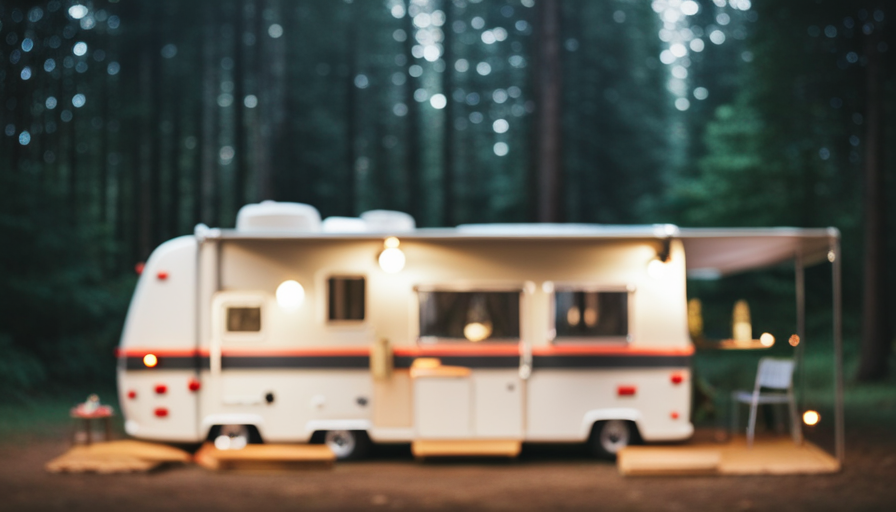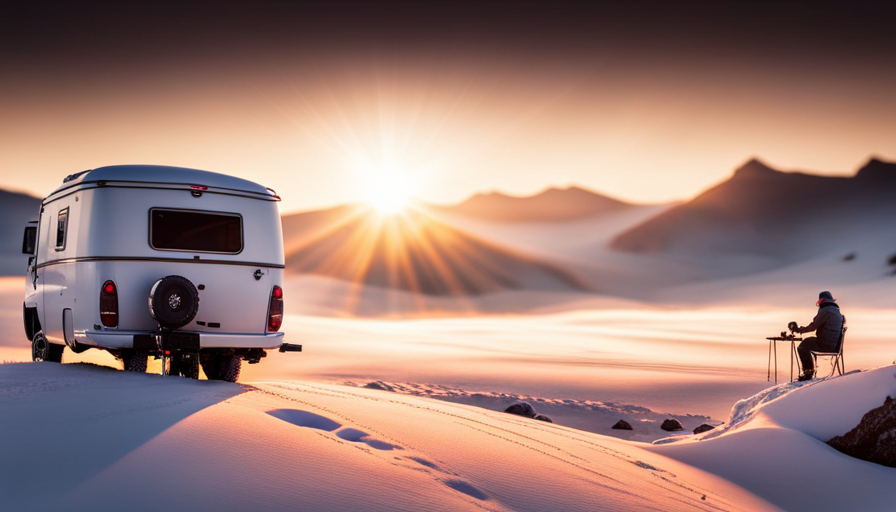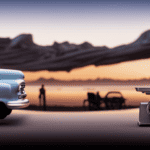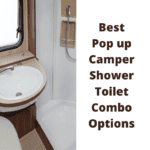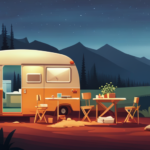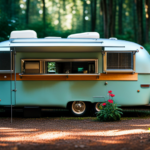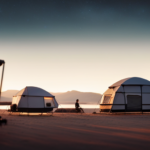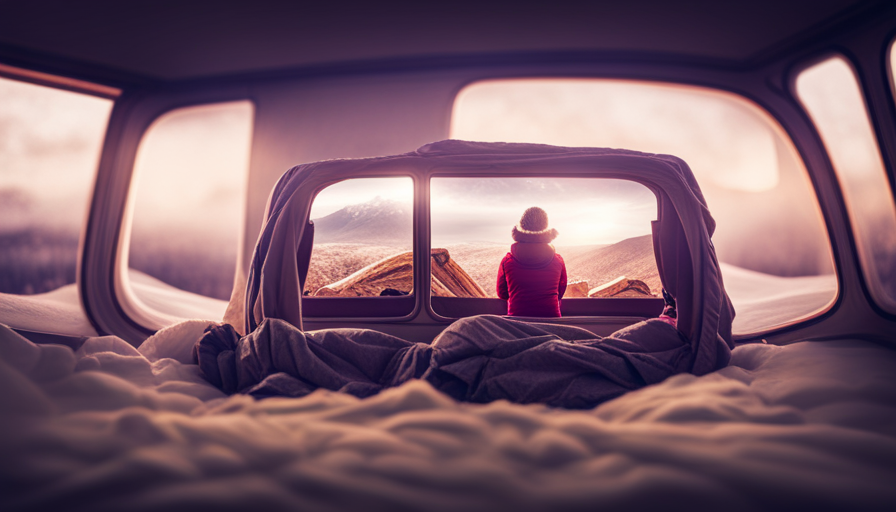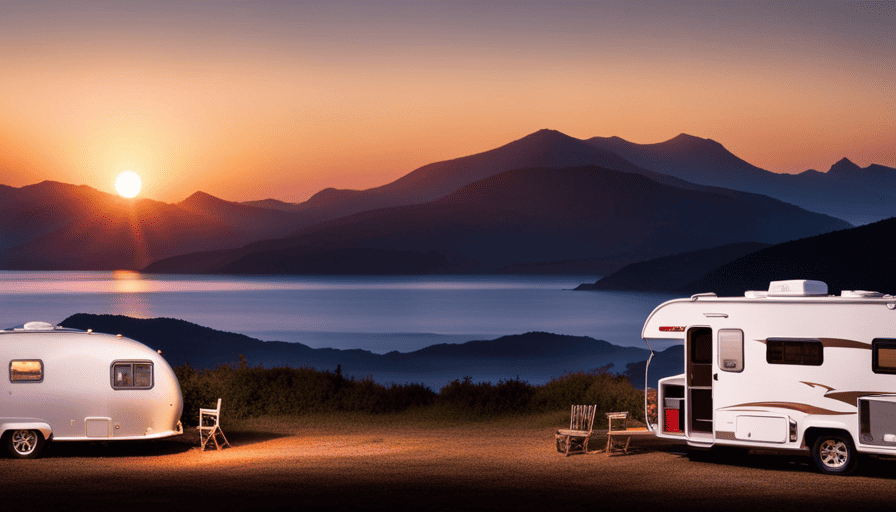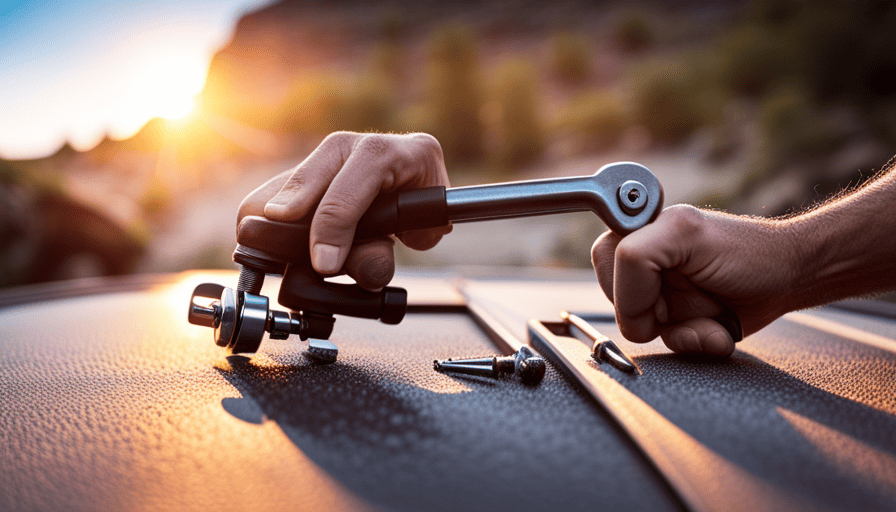In a world teeming with urban sprawl and hectic lifestyles, there are moments when we crave a more straightforward, daring getaway. A chance to rekindle our bond with nature, relax, and craft memories that will endure forever.
Enter the pop-up camper, a symbol of freedom and versatility in the realm of outdoor exploration. These ingenious portable shelters offer a unique way to experience the great outdoors, providing a comfortable and convenient home away from home. With their collapsible design and lightweight construction, pop-up campers allow us to embark on spontaneous adventures without compromising on comfort.
Whether you’re a seasoned camper or new to the camping scene, pop-up campers offer a range of options to suit your needs and preferences. Join us as we delve into the world of pop-up campers, exploring their many features, advantages, and safety considerations.
Get ready to discover the joy of embracing nature while still enjoying the comforts of home with a pop-up camper.
Key Takeaways
- Pop-up campers are portable and versatile shelters that provide both indoor and outdoor living spaces.
- They are compact and lightweight, making them easy to store and tow.
- Pop-up campers are affordable compared to other types of RVs and offer convenience, comfort, and affordability for outdoor enthusiasts.
- Regular maintenance and proper setup and take down are essential for extending the lifespan of a pop-up camper.
Definition and Purpose of a Pop-up Camper
If you’re looking for a versatile and convenient camping option, a pop-up camper is the perfect choice for you. A pop-up camper, also known as a folding camper or tent camper, is a type of recreational vehicle that is collapsible for easy towing and storage. It is designed to provide a comfortable camping experience while still offering the freedom of being outdoors. When choosing a pop-up camper, it’s important to consider the weight and towing capacity of your vehicle. Be sure to consult a pop up camper weight guide to determine the appropriate size and weight for your specific needs. With a pop-up camper, you can enjoy the convenience of a compact and lightweight trailer, while still having the comfort and amenities of a traditional RV.
The main benefit of owning a pop-up camper is its compact size and lightweight construction. When collapsed, it’s significantly smaller than traditional RVs, making it easier to store and maneuver. This also means that it can be towed by a wider range of vehicles, including smaller cars and SUVs. Additionally, the materials used in pop-up campers are typically lighter, resulting in improved fuel efficiency during transportation.
Another advantage of pop-up campers is their ability to provide both indoor and outdoor living spaces. The main body of the camper features sleeping quarters, a small kitchenette, and storage space. The sides of the camper can be expanded or folded out to create additional living space, usually covered with a tent-like material. This allows campers to enjoy the best of both worlds, with the comfort of an enclosed space and the freedom of being outdoors.
Transitioning into the subsequent section about types of pop-up campers, it’s important to understand the different options available when choosing a pop-up camper that suits your needs.
Types of Pop-up Campers
When you’re looking for a portable and practical way to enjoy the great outdoors, consider exploring the various types of foldable trailers available. Pop-up campers, also known as tent trailers or folding campers, come in different sizes and offer a range of features to suit your needs. These campers are designed to be lightweight and easy to tow, making them a popular choice for outdoor enthusiasts.
One type of pop-up camper is the A-frame camper, which features a triangular design that provides ample interior space when unfolded. Another type is the basic tent trailer, which has canvas walls that can be raised to create additional living space. There are also hybrid pop-up campers that combine the features of a traditional travel trailer with those of a pop-up camper.
When considering a pop-up camper, it’s important to take into account the weight limits. Different models have varying weight capacities, so it’s crucial to ensure that your vehicle can safely tow the camper you choose. Additionally, consider the size of the camper when folded down, as this will impact storage and towing.
The different sizes and weight limits of pop-up campers allow for a variety of options when choosing the right one for your outdoor adventures. Now, let’s explore the advantages of pop-up campers.
Advantages of Pop-up Campers
Looking to enjoy the great outdoors? Consider exploring the advantages of these portable and practical foldable trailers for your camping adventures. Pop-up campers offer a range of benefits that make them a popular choice among outdoor enthusiasts. Here are some pros and cons of pop-up campers to help you make an informed decision:
Pros:
- Versatility: Pop-up campers are compact and lightweight, making them easy to tow and maneuver. They can be easily set up and taken down, allowing you to explore various camping locations.
- Affordability: Compared to other types of RVs, pop-up campers are more budget-friendly. They offer a cost-effective way to enjoy camping without breaking the bank.
- Accessibility: With their low-profile design, pop-up campers can access remote campsites that may be inaccessible to larger RVs. This opens up a whole new world of camping possibilities.
Cons:
- Limited Space: While pop-up campers provide comfortable sleeping quarters, they usually have limited living space. This can be a drawback for larger families or those who prefer more room during their camping trips.
- Weather Sensitivity: Pop-up campers may not be as well-insulated as other RVs, making them more susceptible to extreme weather conditions.
- Set-Up Time: Setting up a pop-up camper can take some time and effort, especially for beginners. It requires proper leveling and securing to ensure stability and safety.
When considering the best destinations for pop-up camping, think about places that offer beautiful scenery, outdoor activities, and amenities such as hiking trails, fishing spots, or access to water bodies. Now, let’s explore the features and amenities of pop-up campers.
Features and Amenities of Pop-up Campers
To fully enjoy your camping experience, you’ll want to know about the features and amenities that come with these versatile trailers. For example, the average weight of a pop-up camper is around 2,000 pounds. Pop-up campers are known for their compact size and lightweight design, making them easy to tow and maneuver. Despite their smaller size, these campers are packed with features that provide comfort and convenience on your outdoor adventures.
One of the key features of a pop-up camper is its ability to expand, providing additional sleeping space. Most pop-up campers have a foldable design that allows for easy towing and storage. But once you arrive at your destination, you can expand the camper to create a spacious living area. This feature is great for families or larger groups who need extra sleeping space.
Pop-up campers also come equipped with various amenities to enhance your camping experience. Many models include a kitchenette with a sink, stove, and refrigerator, allowing you to prepare meals just like you would at home. Some campers even have a bathroom with a toilet and shower, providing added convenience during your outdoor adventures.
With their compact size and numerous features, pop-up campers offer a range of benefits for campers. They provide a comfortable and convenient way to enjoy the great outdoors without sacrificing the comforts of home. Pop-up campers are designed to be lightweight and easy to tow, making them a popular choice for those who want to explore different camping destinations. They can easily be set up at the campsite, and their collapsible design makes them easy to store when not in use. Many people are also intrigued by how pop up campers work, as they often feature expandable sections that can be folded out to create additional living space, making them a versatile and convenient option for outdoor enthusiasts.
In the next section, we will discuss how to set up and take down a pop-up camper, ensuring you have a smooth and hassle-free camping experience.
Setting Up and Taking Down a Pop-up Camper
Setting up and taking down a pop-up camper is a breeze with its user-friendly design and convenient features. When it comes to setting up, there are a few common mistakes that people often make.
One is not properly leveling the camper, which can lead to discomfort during sleep and issues with appliances. It’s important to use a leveling tool and adjust the camper until it’s perfectly even.
Another mistake is not properly securing the camper to the ground, which can be dangerous in windy conditions. Anchoring the camper and using stabilizing jacks will ensure its stability.
When it’s time to pack up the pop-up camper, efficiency is key. One tip is to clean and organize the interior before collapsing it. This will make the process smoother and prevent any belongings from getting damaged.
It’s also important to properly fold and secure the canvas and awning to avoid any tears or damage. Additionally, taking inventory and creating a checklist will help ensure that nothing is left behind.
As we transition into the next section about maintenance and care for pop-up campers, it’s important to note that proper setup and take down are essential for the longevity of the camper. Regular maintenance, such as cleaning and inspecting the camper for any damage, will help extend its lifespan and ensure a safe and enjoyable camping experience.
Maintenance and Care for Pop-up Campers
Make sure you regularly inspect and clean your camper to prevent any potential damage or safety hazards, as studies have shown that neglecting maintenance can lead to a significant increase in accidents and costly repairs. Here are some maintenance tips to keep your pop-up camper in great shape:
-
Check the roof: Inspect the roof for any cracks or leaks. Repair any damages immediately to prevent water damage inside the camper.
-
Clean the canvas: Regularly clean the canvas with a mild soap and water solution to remove dirt and stains. Make sure it’s completely dry before folding the camper.
-
Lubricate moving parts: Apply lubricant to hinges, lift systems, and other moving parts to ensure smooth operation. This’ll prevent unnecessary wear and tear.
-
Check the tires: Examine the tires for any signs of wear or damage. Inflate them to the recommended pressure and replace them if necessary.
Common issues to look out for include mold or mildew growth, electrical problems, and plumbing leaks. Address these issues promptly to avoid further damage.
As you move into the section about popular pop-up camper brands, it’s important to consider the maintenance requirements of each brand.
Popular Pop-up Camper Brands
One of the most sought-after pop-up camper brands is Jayco, known for their durable construction and comfortable interiors. They offer a range of popular pop-up camper models that cater to different camping needs.
One such model is the Jay Series Sport, which is lightweight and easy to tow. It features a spacious interior with amenities like a comfortable bed, a dinette area, and a small kitchenette.
Another popular model is the Jay Sport, which offers a larger floorplan and more amenities such as a toilet and shower.
One of the pros of pop-up campers is their compact size and easy towing capabilities. They’re also more affordable compared to larger RVs and offer a more authentic camping experience. However, there are some cons to consider as well.
Pop-up campers may not provide as much insulation as a hard-sided RV, making them less suitable for extreme weather conditions. They also have limited storage space and may require more maintenance compared to other types of campers.
In the next section, we’ll provide tips for choosing the right pop-up camper that suits your camping needs and preferences.
Tips for Choosing the Right Pop-up Camper
When it comes to choosing the right pop-up camper, there are several factors to consider. These factors will help ensure that you find the perfect camper to suit your needs and preferences.
Here are four key considerations to keep in mind:
-
Size and Weight: Determine how many people will be using the camper and how much gear you need to bring along. This will help you choose a camper with the right size and weight capacity.
-
Amenities: Consider the amenities you want in a camper, such as a kitchenette, bathroom facilities, and storage space. Make a list of must-have features to narrow down your options.
-
Set-Up and Take-Down: Evaluate the ease of set-up and take-down for each camper you’re considering. Look for features like hydraulic lifts or simple mechanisms that make the process quick and hassle-free.
-
Budget: Determine your budget and stick to it. Remember to consider not only the initial cost of the camper but also ongoing maintenance and operating expenses.
By carefully considering these factors, you can choose a pop-up camper that meets your needs and enhances your camping experience. Now, let’s move on to the next section and discuss some important safety considerations for pop-up campers.
Safety Considerations for Pop-up Campers
To ensure a safe camping experience, it’s crucial that you familiarize yourself with the important safety considerations of using a pop-up camper. One of the main safety concerns is properly securing the camper to prevent accidents or damage. According to a study, improper hitching or towing was the cause of 12% of all pop-up camper accidents.
When it comes to pop-up camper safety, there are a few essential things you need to keep in mind. Firstly, always make sure that the camper is securely attached to your vehicle before hitting the road. Double-check the hitch and ensure it’s properly locked in place.
Additionally, it’s important to distribute the weight evenly inside the camper to prevent any instability. Avoid overloading the camper and be mindful of the weight capacity limits.
Furthermore, be sure to check the tire pressure regularly and inspect the brakes and lights before each trip.
Lastly, don’t forget to pack essential camping gear for pop-up campers, such as a fire extinguisher, first aid kit, and emergency roadside kit.
By following these safety considerations, you can have a worry-free camping experience in your pop-up camper.
As we conclude, it’s important to highlight the popularity and versatility of pop-up campers.
Conclusion: The Popularity and Versatility of Pop-up Campers
As you wrap up your camping trip, take a moment to appreciate the widespread appeal and adaptability of these compact and versatile camping companions. Pop-up campers have gained immense popularity in recent years, and it’s no surprise why.
These ingenious campers offer a multitude of benefits that make them a must-have for outdoor enthusiasts.
One of the main reasons for their popularity is their versatility. Pop-up campers are designed to be lightweight and easy to tow, making them suitable for a wide range of vehicles. Whether you have a small SUV or a larger truck, there’s a pop-up camper that’ll fit your needs.
Additionally, these campers are incredibly easy to set up and take down, allowing you to spend more time enjoying your trip and less time dealing with complicated tent setups.
Owning a pop-up camper also comes with a host of other benefits. These campers often come equipped with amenities such as comfortable sleeping quarters, a small kitchenette, and even a bathroom. This means you can enjoy the comforts of home while still being immersed in nature.
Furthermore, pop-up campers are more affordable compared to larger RVs, making them a great option for those looking to experience the joys of camping without breaking the bank.
The popularity of pop-up campers is well-deserved. These versatile camping companions offer a wide range of benefits, from their ease of use to the added comfort they provide. If you’re an outdoor enthusiast looking for a convenient and affordable way to enjoy the great outdoors, a pop-up camper is definitely worth considering.
Frequently Asked Questions
How much does a pop-up camper typically weigh?
Pop-up campers typically weigh between 1,000 and 3,000 pounds. The weight of a pop-up camper can vary depending on its size and features.
These campers are designed to be lightweight and easy to tow, making them a popular choice for outdoor enthusiasts. Despite their compact size, pop-up campers offer various features such as sleeping quarters, dinettes, storage space, and even amenities like a small kitchenette.
They provide a comfortable and convenient camping experience while still being portable.
Can a pop-up camper be towed by a small car?
Towing a pop-up camper with a small car depends on the car’s towing capacity. Pop-up campers are generally lightweight and can be towed by smaller vehicles with adequate towing capacity.
However, it’s important to consider the pros and cons. While smaller cars offer better fuel efficiency, they may struggle with stability and braking. It’s crucial to check your car’s towing capacity, consider the weight of the camper, and ensure proper safety measures are in place before towing.
Are pop-up campers suitable for all seasons?
Pop-up campers can be suitable for all seasons, including winter camping, with proper care and maintenance.
It’s important to insulate the camper to keep it warm and prevent freezing. Adding insulation to the windows and doors, using thermal curtains, and sealing any gaps can help retain heat. Additionally, using a skirt around the bottom of the camper can prevent cold air from entering.
Regularly checking for leaks, clearing snow off the roof, and using an electric heater are also important maintenance tips for winter camping.
How long does it take to set up and take down a pop-up camper?
Setting up and taking down a pop-up camper can vary depending on experience and the specific model. It typically takes around 30 minutes to an hour to set up and take down a pop-up camper.
The pros of a pop-up camper include their compact size and affordability. However, a con is that they require more effort to set up compared to other types of campers. To speed up the process, some tips include practicing the setup beforehand, having a checklist, and using a leveling tool.
What is the average lifespan of a pop-up camper?
The average lifespan of a pop-up camper is around 10 to 15 years with regular maintenance. However, this can vary depending on usage and care. It’s important to perform routine maintenance, including checking for any leaks, inspecting the canvas for wear and tear, and ensuring the electrical and plumbing systems are in good working order. Common problems with pop-up campers can include water damage, issues with the lift system, and wear on the canvas material.
Are Murphy Beds Commonly Found in Pop-Up Campers?
Murphy beds in campers, also known as fold-up beds, offer a practical space-saving solution for those living life on the go. These innovative sleeping arrangements allow campers to maximize the limited space inside their pop-up campers. In essence, the murphy bed in camper explained denotes a bed that can be stowed away against the camper’s wall during the day and conveniently pulled down for a good night’s rest. By incorporating such beds, pop-up campers optimize their interior layout, making them a popular choice among camping enthusiasts.
Conclusion
In conclusion, pop-up campers have become increasingly popular among outdoor enthusiasts due to their versatility and convenience. They offer a great alternative to traditional RVs with their compact design and lightweight construction.
One interesting statistic to note is that the sales of pop-up campers have seen a significant increase of 36% in the past year, according to a study conducted by the RV Industry Association. This demonstrates the growing trend of people opting for pop-up campers as a way to enjoy the outdoors.
Whether you’re a seasoned camper or just starting out, a pop-up camper is definitely worth considering for your next adventure.

